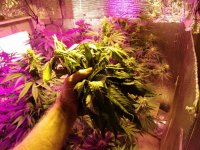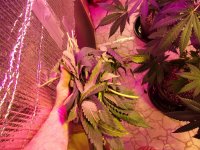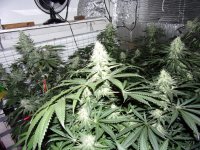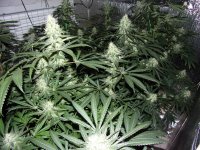-
ICMag with help from Landrace Warden and The Vault is running a NEW contest in November! You can check it here. Prizes are seeds & forum premium access. Come join in!
You are using an out of date browser. It may not display this or other websites correctly.
You should upgrade or use an alternative browser.
You should upgrade or use an alternative browser.
DIY and other hydroponic formulas.
- Thread starter CannaT
- Start date
These plants are transpiring water too fast and drying out before watering day, (3rd day). Since I have another 4 or 5 weeks left in this grow, I have to slow transpiration down by removing a few handfuls of leaves. By removing the leaves I will remove millions of stomata's and cut transpiration 25% or more. It's important to never remove leaves when the soil is dry because it will shock the plant big time and slow down growth. Only remove leaves after a good watering so the wounds will have enough water to scab and heal fast. 
Attachments
Balancing the Elements.
Having the same EC ratio in the medium and the same EC in the plants is key
Also, the most important thing to understand regarding fertilization is that plant growth is controlled by the mineral nutrient in the shortest supply, even when sufficient quantities of other nutrients exist., The consequence of this is a single nutrient element may be the only factor limiting plant growth even if all other elements are supplied in abundant quantities.Having the same EC ratio in the medium and the same EC in the plants is key
Using these feeding rates allows me to keep a constant nutrient supply in the root zone. More isn't what counts when it comes to supplying elements to the plant. The nutrient being present is what matters the most when it comes to the usefulness of using fertilizers. Here are the feeding rates that could be used with this method. I like using the constant topwater feed the most, but they all would work well. 
Feed rates
Constant feed (160 ppm) top every watering
Periodic feeding (350 ppm) weekly
"Every other week" (700 ppm) bi-weekly
Feed rates
Constant feed (160 ppm) top every watering
Periodic feeding (350 ppm) weekly
"Every other week" (700 ppm) bi-weekly
Many growers were taught to routinely leach their crop in order to prevent salts from building up in the root medium. While leaching can be a valuable tool for removing (excess salts) from the root medium, regular leaching is not necessary if the irrigation water and fertilizer contain few impurities such as sodium and chloride. Since leaching is completely controlled by the grower, it can be used as a valuable tool, to regulate the pH and EC. A grower can choose to hold or release nutrients according to the plant's needs. 
Applying high fertilizer concentrations (400 ppm) to a crop requires that you use high leaching rates (55 percent) or salt levels in the media will increase to unacceptable levels for growth. Low fertilizer concentrations (100 ppm) can be used to grow most crops, but only if leaching levels are at or near zero. In fact, it was demonstrated that similar nutrient levels could be maintained in the root medium using a fertilizer concentration of 100 ppm with zero leaching or 400 ppm with 55 percent leaching
I hope I didn't bore you with the fertilizer stuff because it is for newbies only. I can't rotate my plants anymore because the buds are sagging and interwoven together if I move them the limbs will break. I will have to crawl around the pots on the floor on watering days.
Here's today photos and update.
Here's today photos and update.
Attachments
Right, when I think I have it figured out the plant changes her needs. Instead of cations, she now wants the opposite, she wants anions for flowering. That means time to drop the +nitrogen +calcium and any other +cation that will block or interfere with the receptor sites. Instead of a positive charge molecule, she wants a negative one that is not mobile. Since phosphorus is negatively charged it is not mobile so I have to bring the phosphorus to her and let her take what she can. In order for the anion to link up for plant use it attaches to iron or aluminum and becomes available to the plant. Micronutrients are so important to use with flowering nutrients for this reason. 
The organic core I inserted in the soil-less mix, in the beginning, is pretty much lost its favor now. The core is basically negatively charged and the plant wants phosphorus which is a negative charge anion. Now the best way to get the phosphorus to the plant is by nutrient saturation. By removing any impurity from a nutrient solution and lowering the pH slightly the plant will take up all the anion molecules it can easily. Pure water and pure nutrient with a favorable pH are very important at this point. 
Best soil pH between 6 and 7 will result in maximum phosphorus availability. At low pH (acidic soils), soils have greater amounts of aluminum and iron, which form very strong bonds with phosphate. 
No, I don't add anything but pure water with liquid nutrients now. No buffering is needed because the pH is in the right range. Any buffering will weaken and block receptor sites where phosphorus exchanges. Calcium will limit phosphorus exchange. Only using General Hydroponics Flora series, Micro and Bloom only for the rest of the grow, no nitrogen, cal-mag, or any additives. .
Above I said phosphorus is negatively charged and it is not mobile, that is to say, in the soil, however, phosphorus is mobile in the plant. I will use that mobile nutrient stored in the leaves at the right time in the future if all goes well. 
My soilless mix has a "6.4 PH CaCl buffer". How do i treat it? Any special stuff or it will wear out in time?
Its always going to be there but much less at the end of the grow. All the feed water going through for the last 6 weeks will weaken the bonds and should be about buffered out. Timing is important.
It's so simple and easy too, just using rainwater with "micro, and "bloom only, feeding with every watering. When I put the fertilizer in the rainwater it comes out with a pH of 6.2. ready to use and no need to do anything else, so easy. 
My soilless mix has a "6.4 PH CaCl buffer". How do i treat it? Any special stuff or it will wear out in time?
Do you mean CaCO[SUB]3 instead of CaCl ?
Yeah. Probably I misremembred. Sorry. Will check later.
Later.edit: its cacl2. Suposedly giving out mg, ca and N if I was to trust their nutrient table. But says nothing about the Cl... thats not that good for plants in high concentration, right?
Also, I checked runoff PH and it was ok-ish, but man the tds was 2400 ppm out from 130 ppm in. Is that my buffer getting washed out or the soil was simply too fertilised? I certainly never feed that much to result in those ppm numbers. Something's fucky.
Plants look like this, they are under 3 weeks old from seed:
 They would look way worse but I kept them happier with foliar feeds, meanwhile trying to fix the soil situation that I was thinking it's high PH at first, turns out its high tds. Bummer.
They would look way worse but I kept them happier with foliar feeds, meanwhile trying to fix the soil situation that I was thinking it's high PH at first, turns out its high tds. Bummer.
Also sorry for taking up space in your thread! Hope you can help me with some advice on how to fix it. Or at least understand it better so i can research fixing it.
Creeperpark , mention so you see my edit.
Later.edit: its cacl2. Suposedly giving out mg, ca and N if I was to trust their nutrient table. But says nothing about the Cl... thats not that good for plants in high concentration, right?
Also, I checked runoff PH and it was ok-ish, but man the tds was 2400 ppm out from 130 ppm in. Is that my buffer getting washed out or the soil was simply too fertilised? I certainly never feed that much to result in those ppm numbers. Something's fucky.
Plants look like this, they are under 3 weeks old from seed:
Also sorry for taking up space in your thread! Hope you can help me with some advice on how to fix it. Or at least understand it better so i can research fixing it.
Creeperpark , mention so you see my edit.
Last edited:
When you are using an organic charge the ppm will be high and that's normal (2400 ppm). The trick is that the plants must be started in the mix and they will adjust as they grow in the high EC. Don't add any nutrients when the ppm is high like above. You can hold the 2400 ppm and let the plants use those nutrients. Use only pure water without anything until the ppm goes down. Keeping the pH above 6.2 will allow the high EC from burning the tips. 
Sounds good man. Thank you for the help and also please know that your first sentence calmed me a bit. As i did used some products that were high in organic matter.
When should I think about feeding? I will check ph and ppm of runoff every few waterings. And would be nice to have some pointers so I know what to do and what to wait for before feeding.
When should I think about feeding? I will check ph and ppm of runoff every few waterings. And would be nice to have some pointers so I know what to do and what to wait for before feeding.













